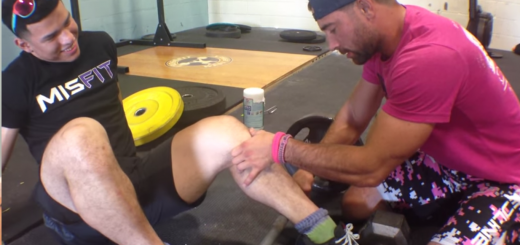Over-Training and CNS Fatigue
Not hitting your PR’s lately? More sore than usual, despite taking adequate rest? Are you irascible during your workout, or have a feeling of ‘exercise contempt’? Not only are over-trained, but now you are taxing your Central Nervous System – the powerhouse that runs your body.
We all love to train. Moreover, we love to get better, physically. However, sometimes the lure of achieving the greatest level of fitness and performance presents the problem of taking on more than your body is ready to undergo. Sound familiar? Higher training volume, intensity, and frequency are the usual protocols for many who want to get stronger and faster — a principle known as progressive overload. Though it is a widely practiced concept, it can often be done haphazardly and the costs are often overlooked. This series aims to examine the consequences of hard(er) training: overtraining syndrome and CNS (central nervous system) fatigue.
What are overtraining syndrome and CNS fatigue?
Before delving further into specifics, it is important to note that every activity the body is put through is a stressor (i.e., eating, exercising). Stress is a necessary variable in physical growth and adaptation, but it demands a level of balance with rest and recovery. If this balance is lacking, stress overwhelms the body and leads to a decline in overall health. Naturally, the consequences and symptoms of each can and do overlap.
Overtraining Syndrome
Overtraining syndrome is a ubiquitous term throughout the majority of athletic training circles. In short, it is a culmination of engaging in greater than usual physical demands that exceed the body’s ability to adapt and recover sufficiently. Coupled with mental stress, the signs and symptoms are physical, behavioral, and emotional, including:
- Washed-out feeling, tired, drained, lack of energy
- Mild leg soreness, general aches and pains
- Pain in muscles and joints
- Sudden drop in performance
- Insomnia
- Headaches
- Decreased immunity (increased number of colds, and sore throats)
- Decrease in training capacity / intensity
- Moodiness and irritability
- Depression
- Loss of enthusiasm for the sport
- Decreased appetite
- Increased incidence of injuries.
- A compulsive need to exercise
Mechanisms of overtraining syndrome
So what exactly causes overtraining syndrome? There are numerous hypotheses, but all deal with the imbalance between training volume/intensity and recovery. A simple example would be failure to adequately replenish glycogenstores via proper nutrition following frequent high volume training. In turn, muscles are overworked, quick to fatigue with each following session, and begin pulling energy from elsewhere — further stressing the body and starting a domino effect of problems.
Similarly, adrenal fatigue is another phenomenon that may result from all this chaos. Though mostly theoretical in the contemporary field of medicine, the logic driving the idea of this dysfunction is intense or prolonged periods of stress that overwork the adrenal glands. This, in turn, blunts and inhibits the release of stress hormones, the balance of which is imperative for regular functioning both physiologically and socially. For example, epinephrine(adrenaline) “increases the heart rate and force of heart contractions, facilitates blood flow to the muscles and brain, causes relaxation of smooth muscles, helps with conversion of glycogen to glucose in the liver, and other activities.”
In summary, overtraining syndrome is a result of multiple factors and variables that encompass both physical and mental demands that exceed the recovery capacity of the body.
CNS Fatigue
Concept check: All nerves exiting the brain stem and spinal cord comprise theperipheral nervous system. This is how the brain (i.e., motor cortices, somatosensory cortices, etc.) communicates with skeletal muscles via theneurotransmitteracetylcholine, among other things.
CNS fatigue (CNS = central nervous system) is a slightly more convoluted phenomenon, but the term is thrown around frequently in the world of fitness. By itself, the acronym evokes notions of frailty, complication, and extreme caution. Why? If you have been exposed to any type of human science course, you know that the CNS is the conduit through which the brain communicates with the body (can’t mess with that!). A concrete explanation of this phenomenon, however, is difficult to hunt down.
Whereas overtraining syndrome casts a wide net with its causative factors and symptoms, CNS fatigue is much more specific. As implied by its name, this dysfunction originates in the brain, brain stem, and spinal cord. It deals primarily with the neuromuscular junction. Just as with all systems in the body, neuromuscular communication has a threshold and working this system to capacity (frequent intense training) leads to fatigue or burnout.
Symptoms of CNS fatigue can include:
- Decrease in performance
- Increased resting heart rate
- Slowed reflexes
- Irritability
- Loss of motivation
- Decreased sex drive
- Mental sluggishness
- Discomfort in any physical exertion.
Mechanisms of CNS fatigue
With the brief background on the physiological mechanics of the CNS, we can better understand the theories behind why it occurs. A great excerpt by Matt Perryman fromMyosynthesis serves as a primer:
Any time you move, the brain lights up with nerve impulses generated by chemical activity. A stream of these impulses flows from the brain to the working muscles, causing them to contract. We call this flow of nerve impulses ‘central drive’, which we can measure through various methods of arcane science. After some kinds of intense training, we see that central drive is reduced, causing a kind of fatigue even if the muscles are fine.
Revisiting the principle of progressive overload, we know that in order to get stronger or faster we gradually have to habituate the body to greater amounts of training. The endurance athlete may begin running or cycling further each week; the strength athlete may increase working loads and training volume; and so forth. Whether it is the competitive aspect of training or the “high” of dopamine, many of us tend to take it too far and overlook the principle of diminishing returns. Without knowing how to cope, we continue training even harder. However, if we have learned anything about the body throughout our training, we know it constantly strives forhomeostasis.
Among the theories of CNS fatigue, perhaps the most popular is the central governor theory. The idea was first introduced in 1924 by physiologist Archibald Hill, but often credited to Tim Noakes in 1997. Matt Perryman sums it up:
The idea is that your brain is constantly monitoring the physical work done by your muscles and cardiovascular system, and that monitoring process is what we experience as a sensation of effort. Your brain, says Noakes, has a safety margin which is intended to stop you from hurting yourself by pushing to true physical exhaustion. When you reach that point, the brain effectively pulls the plug on motor drive — the nerve impulses that make you go — and you experience this as a feeling of tiredness and exhaustion.
In line with this idea of a physiological governor is the theory that some people reach a point where the body has problems keeping up with neurotransmitter release and/or end-plate coupling (i.e., poor muscle activation via neurotransmitter binding). Again, the theme is the same: working systems to capacity damages homeostasis and physiological functioning.

Other theories cite inadequate nutrition, such as too low of a carbohydrate intake in proportion to physical demands as well as low levels of amino acids in the bloodstream.
Overall, these are just theories and have yet to be thoroughly researched, especially in the realm of anaerobic training. The anecdotal evidence seems to be very convincing, however. Now armed with this working knowledge, what can be done to prevent or mitigate this from happening to you? Is this or should this even be a concern to you? In the next and final part of this series, we will address these topics and more.
Original Article by STEVE KPA at TabataTimes










